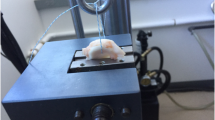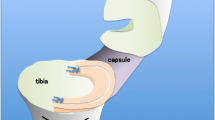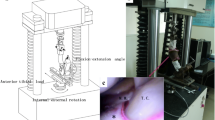Abstract
We report the load to failure in tensile testing of the MaxFire™ meniscal repair system (Biomet Inc, Warsaw, IN) and compare it to other current meniscal repair devices and mattress suture techniques. After creating a longitudinal tear in 42 one-year-old bovine menisci, 7 specimen groups defined by the meniscal repair device, suture, and/or mattress technique used for meniscal repair were randomly established: (Group 1: Fiberwire™ vertical mattress (VM), Group 2: Fiberwire™ horizontal mattress (HM), Group 3: FasT-Fix™ VM, Group 4: FasT-Fix™ HM, Group 5: RapidLoc™, Group 6: MaxFire™ VM, Group 7: MaxFire™ HM). After completing the repairs, the meniscal specimens were cyclically pre-loaded before load to failure testing was performed. The mean load to failure for each group was: Fiberwire VM (185 ± 41 N), Fiberwire HM (183 ± 36 N), FasT-Fix VM (125 ± 8 N), FasT-Fix HM (107 ± 29 N), RapidLoc (70 ± 12 N), MaxFire VM (145 ± 44 N), MaxFire HM (139 ± 50 N). An analysis of variance demonstrated a significant difference in the mean load to failure (F = 8.31 P < 0.01). Statistically significant differences were seen between both Fiberwire groups verses FasT-Fix HM and Rapid-Loc (P < 0.05). Three modes of failure were observed: suture breakage (17/42, 40.5%), tissue failure (18/42, 42.9%), and knot failure (7/42, 16.7%). 2-0 Fiberwire™ VM and HM repairs had the highest load to failure of all groups tested. The load to failure for the MaxFire™ meniscal repair system is comparable to other available all-inside meniscal repair systems.






Similar content being viewed by others
References
Albrecht-Olsen P, Lind T, Kristensen G, Falkenberg B (1997) Failure strength of a new meniscus arrow repair technique: biomechanical comparison with horizontal suture. Arthroscopy 13:183–187
Arnoczky SP, Lavagnino M (2001) Tensile fixation strengths of absorbable meniscal repair devices as a function of hydrolysis time. An in vitro experimental study. Am J Sports Med 29:118–123
Asik M, Sener N (2002) Failure strength of repair devices versus meniscus suturing techniques. Knee Surg Sports Traumatol Arthrosc 10:25–29
Barber FA, Herbert MA, Richards DP (2004) Load to failure testing of new meniscal repair devices. Arthroscopy 20:45–50
Barber FA, Herbert MA, Schroeder FA, Aziz-Jacobo J, Sutker MJ (2009) Biomechanical testing of new meniscal repair techniques containing ultra high-molecular weight polyethylene suture. Arthroscopy 25:959–967
Boenisch UW, Faber KJ, Ciarelli M, Steadman JR, Arnoczky SP (1999) Pull-out strength and stiffness of meniscal repair using absorbable arrows or Ti-Cron vertical and horizontal loop sutures. Am J Sports Med 27:626–631
Borden P, Nyland J, Caborn DN, Pienkowski D (2003) Biomechanical comparison of the FasT-Fix meniscal repair suture system with vertical mattress sutures and meniscus arrows. Am J Sports Med 31:374–378
Joshi MD, Suh JK, Marui T, Woo SL (1995) Interspecies variation of compressive biomechanical properties of the meniscus. J Biomed Mater Res 29:823–828
Kocabey Y, Chang HC, Brand JC Jr, Nawab A, Nyland J, Caborn DN (2006) A biomechanical comparison of the FasT-Fix meniscal repair suture system and the RapidLoc device in cadaver meniscus. Arthroscopy 22:406–413
Kocabey Y, Taser O, Nyland J, Doral MN, Demirhan M, Caborn DN, Sarban S (2006) Pullout strength of meniscal repair after cyclic loading: comparison of vertical, horizontal, and oblique suture techniques. Knee Surg Sports Traumatol Arthrosc 14:998–1003
Mehta VM, Terry MA (2009) Cyclic testing of 3 all-inside meniscal repair devices: a biomechanical analysis. Am J Sports Med 37:2435–2439
Miller MD, Kline AJ, Gonzales J, Beach WR (2002) Pitfalls associated with FasT-Fix meniscal repair. Arthroscopy 18:939–943
Miura H, Kawamura H, Arima J, Mawatari T, Nagamine R, Urabe K, Iwamoto Y (1999) A new, all-inside technique for meniscus repair. Arthroscopy 15:453–455
Papageorgiou CD, Gil JE, Kanamori A, Fenwick JA, Woo SL, Fu FH (2001) The biomechanical interdependence between the anterior cruciate ligament replacement graft and the medial meniscus. Am J Sports Med 29:226–231
Post WR, Akers SR, Kish V (1997) Load to failure of common meniscal repair techniques: effects of suture technique and suture material. Arthroscopy 13:731–736
Rankin CC, Lintner DM, Noble PC, Paravic V, Greer E (2002) A biomechanical analysis of meniscal repair techniques. Am J Sports Med 30:492–497
Sweigart MA, Zhu CF, Burt DM, DeHoll PD, Agrawal CM, Clanton TO, Athanasiou KA (2004) Intraspecies and interspecies comparison of the compressive properties of the medial meniscus. Ann Biomed Eng 32:1569–1579
Walsh SP, Evans SL, O’Doherty DM, Barlow IW (2001) Failure strengths of suture vs. biodegradable arrow and staple for meniscal repair: an in vitro study. Knee 8:151–156
Zantop T, Eggers AK, Musahl V, Weimann A, Hassenpflug J, Petersen W (2004) A new rigid biodegradable anchor for meniscus refixation: biomechanical evaluation. Knee Surg Sports Traumatol Arthrosc 12:317–324
Zantop T, Eggers AK, Musahl V, Weimann A, Petersen W (2005) Cyclic testing of flexible all-inside meniscus suture anchors: biomechanical analysis. Am J Sports Med 33:388–394
Author information
Authors and Affiliations
Corresponding author
Rights and permissions
About this article
Cite this article
Aros, B.C., Pedroza, A., Vasileff, W.K. et al. Mechanical comparison of meniscal repair devices with mattress suture devices in vitro. Knee Surg Sports Traumatol Arthrosc 18, 1594–1598 (2010). https://doi.org/10.1007/s00167-010-1188-z
Received:
Accepted:
Published:
Issue Date:
DOI: https://doi.org/10.1007/s00167-010-1188-z




